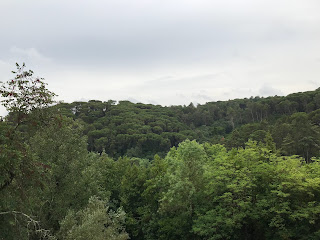I wanted to be a Knight Templar when I was eight. It didn't come to pass
A rather nice bench, Moorish influence fairly obvious, within the Castle's garden walks.
An orange tree for those Templars partial to marmalade on toast
Walls within walls, the Convent of Christ peeping out in the background
Gardens within the walls of the castle
Tomar from the battlements
And its history
The castle of the Templars in Tomar is one of the most important Portuguese military buildings of the C12th. The building of the castle began on March 1st 1218 –the ‘Day of Tomar’ and was designed to defend the borderlands from Muslim incursions. Its builder was Gualdim Pais, Master of the Knights Templar. He was still working on it in 1160, and in 1190 it was put to the test when the armies of Abu Yusuf al-Mansur attacked the castle in force. By the early C13th Tomar had become a Templar owned town, and Gualdim’s statue dominates its central square.
The Knights Templar became a supra European organisation of vast wealth and power, its tentacles everywhere and becoming even more powerful as the years passed. It’s one of history’s great ‘what ifs’ —what if the Knights Templar had continued to grow? How might it have changed history.
But, as every schoolchild knows, the Templars were brutally disbanded by Philip ‘The Fair’ of France. Desperately short of money and with the Pope in his back pocket (Avignon) he accused The Templars of foul heresies, satanism, and spitting on the crucifix amongst other heinous crimes. In 1307, every Templar in France was arrested on the same day.
The process of destroying such a powerful order took some time and considerable savagery, but by 1314 it was over. In that year, Jacques de Moley, Grand Master of the Templars was burnt at the stake, but not before laying a curse on the Pope and the French king. Pope Clement V died in April, a month after the Grand Master. His body was placed in a church overnight; the church caught fire and Clement was burnt to a cinder. Philip IV lived a little longer, dying in November that year, broken, it is said by the immorality of his daughters, and perhaps remembering the Templar’s curse.
Though disbanded elsewhere, things were a little different in Portugal, where King Dinis persuaded Pope Clement’s successor, John XXII, to create a new organisation: the Order of Christ. This new Order took over Templar assets as well as its membership, the Knights Templar carrying on, as it were, under a different name. It assumed control of the great fortress of Tomar in 1357 and over the years added to it—a new cloister in 1557 being one of the best examples of Renaissance architecture in Portugal.
Within the castle is the great Convent of Christ that boasts a fabulous mix of Gothic, Arab and later Renaissance elements, worth a final post next week.
















2 comments:
Great photos. I love your mini history lessons.
re: plant
That plant looks like a type of agave. I've seen a lot of them in Texas and Mexico.
Thanks, Maria. I sometimes have to remind myself I’m not in the classroom 👨🎓😀. Thanks too for the plant info. A reflection of that period of exploration
Post a Comment